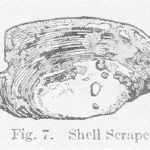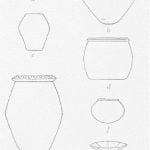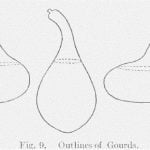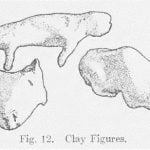
The sedentary life of the Yuchi has given ample opportunity for the development of the art of making pottery. The coiled process is in vogue, but it may be remarked that the modern pots of these Indians are of a rather crude and unfinished form, which is probably traceable to deterioration in later years.
The process of manufacture of ordinary pots for domestic use is as follows. A fine consistent clay is selected and washed in a flat vessel to separate all grit and stones from it. Then lumps are rolled between the palms and elongated in the form of sticks. A flat piece, the size of the bottom of the desired pot, is made and the lengths or sticks of rolled clay are coiled around on this base and so built up until the proper height and form is obtained. Whatever decorations are to be added are now either produced by incision with a sharp stick or by impression with a stick or shell. The whole surface is afterwards scraped with a fresh-water mussel shell, ctangané (Fig. 7), until the outside of the pot is smooth, and then, with the back of the shell, the scraped surface is rubbed to varying degrees of polish, or the hand may be used to give a dull lustre to the surface. The surface is moistened after the clay is dry and then rubbed until it assumes a fairly permanent polish. The pot is next allowed to dry for a few days out of the sunshine. Then it is baked near a fire. When several pots are being baked they are arranged in rows at a little distance from the fire on each side of it and turned at internals. These pots become hard and brick-like and may be used directly over flames. If they are not baked they arc used as household receptacles or dishes and not put near fire. This industry is entirely in the hands of women.

Pots, sea’cu didané, ‘earthen bowl,’ or dida”‘ (PI. III), which are made in general for ordinary’ domestic use are of several different shapes. The outlines shown in Fig. 8, a, b, c, d, f are the commonest. The low fiat type, a, is ordinarily used for food dishes or receptacles for boiled beans and corn. They are usually about eight inches in diameter and three in height. A series of conventional straight lines running obliquely is often incised upon these vessels for the purpose of decoration, but without any known interpretation. Outline b shows the shape of a class of pots used for boiling vegetables. They are held upright by means of stones placed around the base. Their size is variable, ranging from those having a capacity of about three quarts to those holding five or six quarts. A little decoration, in the way of shallow impressions of semicircles, frequently appears near the rim of these boiling vessels to give, it is said, a decorative effect. The type represented by c is of an unusually rough and unfinished appearance and is said to be used to mix flour and dough in. The flat bottomed pot d, with a wide opening and almost straight sides, is the regular boiled com soup pot which is made in different sizes according to the size of the family; they hold two quarts at least, and stand about the house or camp with food in them ready to be eaten cold or warm at any time. The two latter types do not bear on them any attempt at decoration whatever. Small cup-like vessels, f, not more than three or four niches broad, with rounded bottoms, are made for general utility in holding seeds and other objects. This is said to be the kind of clay vessel put in the grave with the body at burial.

One type of vessel, however, which is manufactured particularly for ceremonial purposes is invariably ornamented on a specially made portion about the rim. This type of pot (Fig. 8, e, Plate III, Fig. 9) is used as the receptacle for the sacred concoctions at the annual ceremonies, the crescent-shaped im-pressions on the lip being said to represent the sun and moon, the former of which is the chief figure in mythology and the supernatural object of worship in the tribal ceremonies. The height of these pots, two of which are used during the ceremonial events, is never less than twelve inches. The crescent-like impressions are made with a bent-up twig when the clay is soft before being burnt.
The little platter yáda dané (Fig. 8, g, and PI. Ill, Fig. 1), which is about three inches in diameter, is another form for a special purpose. It is made for the use of women who are in seclusion away from the main dwelling during their menstrual periods. As these little trays are only used to carry food in to such women they are left unbaked. When their function has been performed they are destroyed with other objects which have come into contact with women in this state.
It is noticeable in the above pottery forms, which arc designed solely for domestic use, that no particular decoration is given them. But where this does occur at all it is always on or near the rim and never on the body of the vessel. Specimen 5, PI. III, and Fig. 8, b, have a curved impression surrounding the rim which is said to represent the moon. The series of oblique scratches on specimen 8, PI. Ill, had no meaning or name given them.
A question of origin naturally arises here, in relation to the pottery industry of this tribe, which seems to deserve mention at least. The prominence of the gourd shape, or that of the pumpkin or squash, may have had some influence upon the development of forms in Yuchi pottery. The outline figures and the general appearance of pots suggest this question. The Yuchi themselves comment on the similarity between the shape of pots and pumpkins, and when asked about the form of this or that pot, the answer frequently is “It is like a pumpkin or gourd.” The figures show how this similarity in form appears (Fig. 9). The similarity is further carried out by the smoothness of the body of the pots, and the diminishing diameter near the top. The drinking gourds found in use today, and the gourd receptacles used about the camps in the same way as pottery receptacles are similar to these in shape. The suspicion of this relationship between pottery forms and pumpkins or gourds was aroused by the replies given to questions which were asked in trying to find out whether the pottery shapes symbolized or represented anything else. For instance the bowls of wooden spoons are supposed to represent wolf ears.
It may be said of the modern Yuchi pottery forms that, according to the description given by Holmes 1 they bear more resemblance to those of the prehistoric Chesapeake-Potomac group in their prevalent gourd-like outline and lack of ornamentation on the body, than they do to the highly ornamented and complex forms of the Southern Appalachian group.
Clay Figures

The Yuchi men sometimes mould by hand pressure small figures of animals or parts of animals in clay. Just what part these clay figures play in their life it is hard to say. It would seem, however, that they are merely the product of an idle hour or are based on some esthetic motives. Where quite a little work is being done in clay by the women in making pots and by men who are fashioning smoking pipes, it would seem natural that some would idly try to shape, out of the unused material, figures of objects familiar to them in their daily environment. The figures of this sort are rather clumsy and naturally fragile since they are not baked. The specimens on which this description is based are a crudely made lizard about eight inches long, several life-size frogs, and a cow’s head several inches in height (Fig. 12). Another correspondence between the modern Yuchi and the ancient inhabitants of the Southeast is to be found in these clay figures. Mr. Moore in his archaeological explorations of the mounds of Volusia Co., Florida, 2 found numbers of rude clay figures among which some of the animal forms resemble the ones given here and obtained from the modern Yuchi. The general technique in both modern and prehistoric specimens is similar.
Finally it must be noted, in regard to the subject of pottery and work in clay, that this branch of native handicraft has undergone a great deterioration since the beginning of contact between the Yuchi and Europeans, and that the progress of decline in this, as in other arts, has been much more rapid in the last twenty-five years. Most of the specimens described above were obtained by request, whereupon some were brought from remote districts where they may have been in actual use while others were facsimiles made for the occasion by reliable persons.
Citations:
- Twentieth Report Bureau American Ethnology, Pls. exxiv, exxv, exxvi.[↩]
- Collection of the Academy of Natural Sciences of Philadelphia.[↩]
